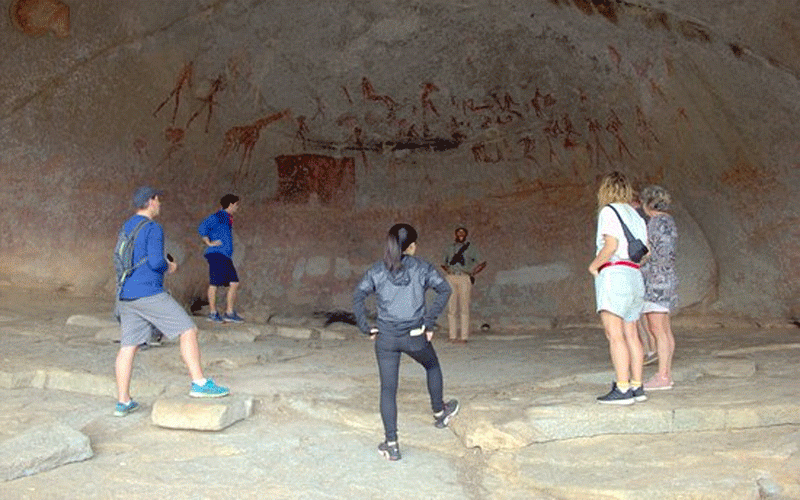
AMAGUGU International Heritage Centre (AIHC) in collaboration with The Friends of the Museum of Human Sciences are working on a project titled Using The Medium Of Art To document and preserve Ancient San-Rock-Art in Matobo World Heritage Site (WHS), which is under threat.
With the support from the US Embassy in Harare — Public Diplomacy department under the Ambassador's Fund for Cultural Preservation the project has its partners such as the University of Zimbabwe (UZ)’s History Heritage and Knowledge Systems Department that will manage the project with the concurrence and support of the National Museums and Monuments of Zimbabwe.
The project will be held at Matobo World Heritage Site in Ward 17 (San rock art sites). It will run for five to six months for the community component then by UZ it will run for five years.
It is aimed at preserving , documenting and artistically capture the ancient San rock art which is under serious threat in the communal lands of Matobo under the WHS, digitally, pictorially, and visually capture the ancient San rock art in the Matobo WHS using the community visual art artists in Ward 17.
It also aims to inculcate a sense of belonging in the community of ward 17 in the Matobo WHS taking a lead role in preserving local cultural heritage which is under serious ecological and human threat among other issues.
Amagugu International Heritage Centre programmes manager Allington Ndlovu confirmed the developments to Standard Style recently.
“The Unesco ICH Convention of 2003 in July gave birth to the inscription of Matobo as one of the WHS in Zimbabwe. It is general knowledge that Zimbabwe prides itself with astonishing five World Heritage Sites among the 135 on the continent. Out of the five sites, two were inscribed based on natural heritage and the remaining three were inscribed based on cultural heritage,”he said.
Ndlovu noted that the five include Victoria Falls, Mana Pools that are natural world heritage sites. Great Zimbabwe and the Khami Monument and Matobo WHS, which were inscribed based on cultural heritage.
- Film has potential of changing economy
- Edutainment mix: Indigenous knowledge in the aesthetics of art
- Science journalists urged to fight ‘infodemic’
- Let’s raise awareness about cybercrimes
Keep Reading
“For purposes of this concept note, it should be pointed out that Matobo, being the WHS to hand, got its WHS status on the basis of its cultural richness that could not be ignored by UNESCO got international recognition and significance as it stimulated cultural tourism in Zimbabwe. It was inscribed in 2003 in because of resident cultural heritages from the numerous human setters," Ndlovu said.
"It was a heritage worth being consumed by the world’s citizens. As archaeologist Thomas Huffman stated, the importance of the Matobo Hills lay in the thousands of San rock art images resident in numerous sheltered caves."
He said the Ndebele people call the San, AbaThwa and they settled among the hills landscape for longer than 13 000 years before the arrival of the Bantu, an Iron Age people who were herders of cattle and agriculturalists “Dombo lina tjilenga” was the catch phrase which captured the essence for the allure of the hills, which provided security and protection of the residents.
Ndlovu said at the same time, the catch phrase gave emphasis to the fact that the hill's environment provided food in the form of available animals and wild fruits.
"Having mentioned this by way of historical background, it is now worth stating that today people worldwide including educational institutions, embassies, governments, art lovers, cinemas, the movie industries specifically Hollywood, confidently comment on the culture, language, traditions, belief systems, and heritage of the San, simply because of their existing heritage in the form of rock art which charms and enchants people in far and wide places in the world," he said.
“The production of movies like The Gods must be Crazy was a typical example of documenting and preserving ancient San rock art through performance arts. This concept in this project, however, seeks to propose the documentation and preservation of San rock art through visual arts — the same genre the San used."
Ndlovu said it was understood that there was no reconstruction of African precolonial history without the appreciation of rock art as it serves as the only living heritage about the early settlers of the region though tucked away inside the hidden caves.
“Ancient San rock art documented their times accurately, it also documented their life, culture, capturing the still moments. It is through rock art that we get to appreciate that the San were a hunter-gatherer community. Right across the Matobo Cultural Landscape there are over a thousand sites with rock art," he said.
“Some have been identified, designated and protected by government institutions such as the National Parks and National Museums and Monuments of Zimbabwe. These include the likes of Pomongwe Cave, Nswatuki, and Silozwane Cave, inter alia. This project therefore seeks to identify, document, and preserve unknown and unprotected rock art sites in the communal lands of Ward 17."
Ndlovu said the methodology made use of the existing artistry within ward 17 identified through some of the annual programs implemented by Amagugu.
"However, rock art serves as an infinite book upon which we learn and enjoy the beauty of San art. Rock art has always carried countless messages of the past about the San people and such knowledge is very rich and requires tapping into our modern world,” he said.
He said there was so much spirituality and knowledge related to medicinal plants, dances, environmental preservation, astrology and many other invaluable themes that are embedded in rock art.
“Given that there are threats bedeviling rock art in unprotected sites in the communal lands, there is an urgent need to document and preserve ancient rock art for posterity, through the use of art and digital methods. In education, rock art serves as a viable teaching tool from primary school level up to tertiary level. Heritage Studies, Fine Art, History, Family and Religious Studies, and Archaeology get the inspiration from rock art. It serves as both a source of history and visual art inspiration," he noted.
“Documenting through production of books, exhibitions and YouTube videos will stimulate academic dialogues that will give birth to various interpretations of the life of these hunter- gatherers, hence serving as some educational and academic stimuli.
“Many students visiting rock art sites add immeasurable value to their appreciation of precolonial history and they get to see the unassailable evidence that surely the San people were once domiciled in the Matobo Hills."
He said the communities in Ward 17 would benefit as prospective custodians of San rock art sites in their localities.
"The approach being employed is community centered as they (community) will be the ones, after being trained by engaged professional artists from VAAB to copy, draw and paint on paper rock art, they will be informed custodians of rock art within their localities, ”he added.
Ndlovu said the beauty and importance of San rock art in both the present and envisioned future is under very serious threats that ought not to be ignored.
“It is worth noting that rock art within the confines of national parks and areas controlled by National Museums and Monuments of Zimbabwe are hardly affected, though climate cannot be controlled as wind, sunshine, rains continue to deface and discolour at a pace that is alarming," he said.
“There have been considerable strides by National Parks and National Museums and Monuments of Zimbabwe to digitally capture some of these cave paintings. That is a worthwhile step in the right direction towards preserving San rock art. However, that is not the case with San rock art in the communal lands where rock art simply lies in caves next to the road unattended, in people’s crop fields, in communal grazing lands and other threatened locations."
Ndlovu said it needed serious intervention strategies that would curb the disappearance of these priceless sites with invaluable San rock art.
"Besides, they are part of the reasons why Matobo was inscribed as one of the world heritage sites in Zimbabwe based on its cultural heritage; the majority of it being intangible cultural heritage,” he said.
He said natural threats such as wind, rain, sunlight and oxidation, and weathering continued to deface, discolor and destroy the precious San rock art, it was also observed that threats that require timeous intervention are also as a result of human agency.
“The majority of rock art sites are in the communal land hence the communal folk consciously and unconsciously pose a serious threat to the actual sites. In the majority of sites, rock art is seriously affected by rain or flowing water in the sheltered rocks. Attached pictures are shocking evidence that water presents the greatest threat to rock art,” Ndlovu said.
“Water flows on top of these paintings and compromises the original reddish pigment. After some time with this continual process, some of the paintings change colour to black and lose the original colour and artistic rendition.










